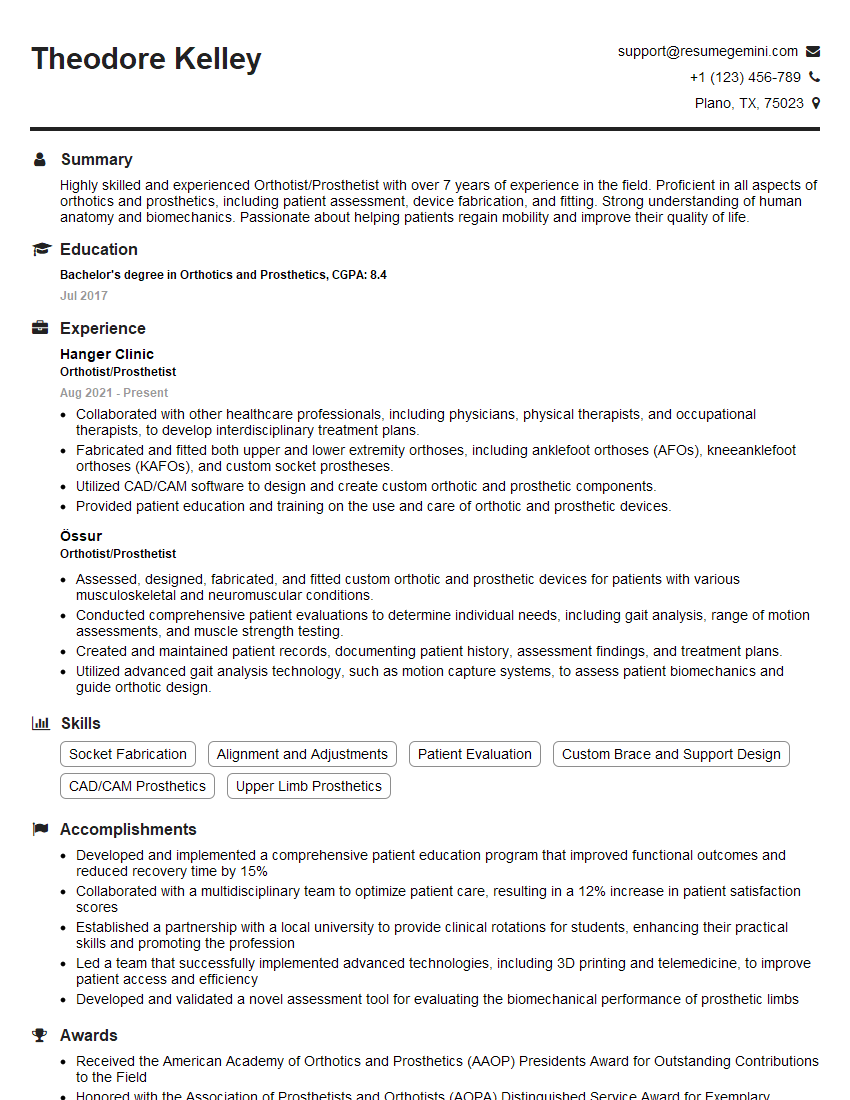Are you a seasoned Orthotist/Prosthetist seeking a new career path? Discover our professionally built Orthotist/Prosthetist Resume Template. This time-saving tool provides a solid foundation for your job search. Simply click “Edit Resume” to customize it with your unique experiences and achievements. Customize fonts and colors to match your personal style and increase your chances of landing your dream job. Explore more Resume Templates for additional options.

Theodore Kelley
Orthotist/Prosthetist
Summary
Highly skilled and experienced Orthotist/Prosthetist with over 7 years of experience in the field. Proficient in all aspects of orthotics and prosthetics, including patient assessment, device fabrication, and fitting. Strong understanding of human anatomy and biomechanics. Passionate about helping patients regain mobility and improve their quality of life.
Education
Bachelor’s degree in Orthotics and Prosthetics
July 2017
Skills
- Socket Fabrication
- Alignment and Adjustments
- Patient Evaluation
- Custom Brace and Support Design
- CAD/CAM Prosthetics
- Upper Limb Prosthetics
Work Experience
Orthotist/Prosthetist
- Collaborated with other healthcare professionals, including physicians, physical therapists, and occupational therapists, to develop interdisciplinary treatment plans.
- Fabricated and fitted both upper and lower extremity orthoses, including anklefoot orthoses (AFOs), kneeanklefoot orthoses (KAFOs), and custom socket prostheses.
- Utilized CAD/CAM software to design and create custom orthotic and prosthetic components.
- Provided patient education and training on the use and care of orthotic and prosthetic devices.
Orthotist/Prosthetist
- Assessed, designed, fabricated, and fitted custom orthotic and prosthetic devices for patients with various musculoskeletal and neuromuscular conditions.
- Conducted comprehensive patient evaluations to determine individual needs, including gait analysis, range of motion assessments, and muscle strength testing.
- Created and maintained patient records, documenting patient history, assessment findings, and treatment plans.
- Utilized advanced gait analysis technology, such as motion capture systems, to assess patient biomechanics and guide orthotic design.
Accomplishments
- Developed and implemented a comprehensive patient education program that improved functional outcomes and reduced recovery time by 15%
- Collaborated with a multidisciplinary team to optimize patient care, resulting in a 12% increase in patient satisfaction scores
- Established a partnership with a local university to provide clinical rotations for students, enhancing their practical skills and promoting the profession
- Led a team that successfully implemented advanced technologies, including 3D printing and telemedicine, to improve patient access and efficiency
- Developed and validated a novel assessment tool for evaluating the biomechanical performance of prosthetic limbs
Awards
- Received the American Academy of Orthotics and Prosthetics (AAOP) Presidents Award for Outstanding Contributions to the Field
- Honored with the Association of Prosthetists and Orthotists (AOPA) Distinguished Service Award for Exemplary Leadership
- Recognized as a Fellow of the International Society for Prosthetics and Orthotics (ISPO) for exceptional contributions to research and innovation
- Recipient of the Orthotics and Prosthetics Research Foundation Grant for groundbreaking research in advanced prosthetic design
Certificates
- American Board for Certification in Orthotics and Prosthetics (ABC)
- National Commission on Orthotic and Prosthetic Education (NCOPE)
- Board Certified Prosthetist-Orthotist (BOC)
- Certified Prosthetist (CP)
Career Expert Tips:
- Select the ideal resume template to showcase your professional experience effectively.
- Master the art of resume writing to highlight your unique qualifications and achievements.
- Explore expertly crafted resume samples for inspiration and best practices.
- Build your best resume for free this new year with ResumeGemini. Enjoy exclusive discounts on ATS optimized resume templates.
How To Write Resume For Orthotist/Prosthetist
- Highlight your clinical skills and experience in your resume.
- Showcase your understanding of human anatomy and biomechanics.
- Quantify your accomplishments whenever possible.
- Get involved in professional organizations and attend industry events.
Essential Experience Highlights for a Strong Orthotist/Prosthetist Resume
- Assess patients to determine their individual needs and develop treatment plans.
- Design, fabricate, and fit custom orthotic and prosthetic devices.
- Conduct gait analysis and other assessments to evaluate patient progress.
- Collaborate with other healthcare professionals to provide comprehensive care.
- Provide patient education and training on the use and care of orthotic and prosthetic devices.
- Maintain accurate patient records and documentation.
- Stay up-to-date on the latest advancements in orthotics and prosthetics.
Frequently Asked Questions (FAQ’s) For Orthotist/Prosthetist
What is the role of an Orthotist/Prosthetist?
An Orthotist/Prosthetist is a healthcare professional who designs, fabricates, and fits custom orthotic and prosthetic devices for patients with various musculoskeletal and neuromuscular conditions.
What are the different types of orthotic and prosthetic devices?
Orthotic devices are used to support, align, or prevent deformity of the body, while prosthetic devices are used to replace missing or damaged body parts.
What is the difference between an Orthotist and a Prosthetist?
An Orthotist specializes in the design and fabrication of orthotic devices, while a Prosthetist specializes in the design and fabrication of prosthetic devices.
What is the education and training required to become an Orthotist/Prosthetist?
A Bachelor’s degree in Orthotics and Prosthetics is typically required, followed by a residency program.
What are the career prospects for Orthotist/Prosthetists?
The job outlook for Orthotist/Prosthetists is expected to grow faster than average in the coming years due to the increasing population of aging adults.
What is the average salary for an Orthotist/Prosthetist?
The average salary for an Orthotist/Prosthetist is around \$75,000 per year.